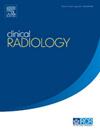心外膜脂肪组织体积对早期发现疑似冠心病患者左心室功能障碍的预测价值。
IF 2.1
3区 医学
Q2 RADIOLOGY, NUCLEAR MEDICINE & MEDICAL IMAGING
引用次数: 0
摘要
目的:探讨心外膜脂肪组织(EAT)、心肌应变与冠心病(CAD)严重程度的关系,评价EAT参数对早期左室(LV)舒张功能障碍的预测价值。材料和方法:2020年纳入170例疑似CAD患者,均行冠状动脉ct血管造影和超声心动图检查。采用商业软件计算LV整体应变。心外膜脂肪组织定义为内脏心包内从肺动脉分叉处至心尖处-190 HU至-30 HU之间的脂肪组织。测量EAT体积和平均衰减值。超声心动图确定左室舒张功能不全。结果:参与者平均年龄56.65±12.64岁,男性占57.65%。EAT体积和平均衰减值与CAD严重程度显著相关。EAT体积与整体纵向应变(GLS)呈显著正相关(r=0.313, p)。结论:EAT参数可以反映CAD的严重程度。EAT容量能够预测早期左室舒张功能障碍。与GLS相比,EAT容量可以更早地预测左室舒张功能障碍。本文章由计算机程序翻译,如有差异,请以英文原文为准。
Predictive value of epicardial adipose tissue volume for early detection of left ventricular dysfunction in patients suspected of coronary artery disease
AIM
To investigate the relationship between epicardial adipose tissue (EAT) and myocardial strain and the severity of coronary artery disease (CAD), and to evaluate the predictive value of EAT parameters in early left ventricular (LV) diastolic dysfunction.
MATERIALS AND METHODS
One hundred seventy patients with suspected CAD who underwent both coronary computed tomography angiography and echocardiography were enrolled in 2020. LV global strains were calculated using commercial software. Epicardial adipose tissue was defined as adipose tissue between -190 HU and -30 HU in the visceral pericardium from the level of pulmonary artery bifurcation to the apical level. EAT volume and average attenuation values were measured. LV diastolic dysfunction was determined by echocardiography.
RESULTS
The mean age of the participants was 56.65 ± 12.64 years, and 57.65% were male. EAT volume and mean attenuation values were significantly correlated with CAD severity. EAT volume was significantly positively correlated with global longitudinal strain (GLS) (r=0.313, P<0.01), and EAT attenuation values were positively correlated with global circumferential strain and GLS (r=0.236, 0.164, respectively, both P<0.05). Age (β = 0.125, OR = 1.134, P<0.01) and EAT volume (β = 0.019, OR = 1.019, P=0.018) were independent predictors of LV diastolic dysfunction. Age combined with EAT volume improved the diagnostic efficacy of left ventricular diastolic dysfunction.
CONCLUSION
EAT parameters can reflect the severity of CAD. EAT volume is capable of predicting early LV diastolic dysfunction. Compared with GLS, EAT volume may be able to predict LV diastolic dysfunction earlier.
求助全文
通过发布文献求助,成功后即可免费获取论文全文。
去求助
来源期刊

Clinical radiology
医学-核医学
CiteScore
4.70
自引率
3.80%
发文量
528
审稿时长
76 days
期刊介绍:
Clinical Radiology is published by Elsevier on behalf of The Royal College of Radiologists. Clinical Radiology is an International Journal bringing you original research, editorials and review articles on all aspects of diagnostic imaging, including:
• Computed tomography
• Magnetic resonance imaging
• Ultrasonography
• Digital radiology
• Interventional radiology
• Radiography
• Nuclear medicine
Papers on radiological protection, quality assurance, audit in radiology and matters relating to radiological training and education are also included. In addition, each issue contains correspondence, book reviews and notices of forthcoming events.
 求助内容:
求助内容: 应助结果提醒方式:
应助结果提醒方式:


